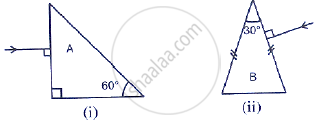Advertisements
Advertisements
Question
After tracing the path of rays of light through a glass slab for three different angles of incidence, a student measured the corresponding values angle of refraction r and angle of emergence e and recorded them in the table given below:
|
S. No. |
∠i |
∠i |
∠e |
|
I |
30° |
20° |
31° |
|
II |
40° |
25° |
40° |
|
III |
50° |
31° |
49° |
The correct observations are:
(A) I and II
(B) II and III
(C) I and III
(D) I, II and III
Solution
(D)
For light rays passing through a glass slab, the following conditions should hold true:
(1) ∠i ≈ ∠e and ∠r < ∠i
(2) Also, with the increase in incident angle, the refracted angle also increases.
Both of these conditions are satisfied in all the three observations.
APPEARS IN
RELATED QUESTIONS
Draw a ray diagram to show the refraction of a monochromatic ray through a prism when it suffers minimum deviation
State the dependence of angle of deviation On the refractive index of the material of the prism.
How is the refractive index of a medium related to the speed of light in it?
Fill in the blanks to complete the following sentence
The refractive index of glass with respect to air is 3/2. The refractive index of air with respect to glass will be ……………….
Fig 4.31 below shows a light ray of single colour incident normally on two prisms A and B. In each case draw the path of the ray of light as it enters and emerges out of the prism. Mark the angle wherever necessary.

A total reflecting right angled isosceles prism can be used to deviate a ray of light through:
(a) 30° (b) 60° (c) 75° (d) 90°.
In an experiment of finding the refractive index of glass, if blue light is replaced by the red light, how will the refractive index of glass change? Give reason in support of your answer.
Light of a single colour is passed through a liquid having a piece of glass suspended in it. On changing the temperature of liquid, at a particular temperature, the glass piece is not seen.
Why is the light of a single colour used ?
A ray of light passes from water to air. How does the speed of light change?
Write a relation between the angle of incidence (i), angle of emergence (e), angle of the prism (A), and angle of deviation (d) for a ray of light passing through an equilateral prism.
